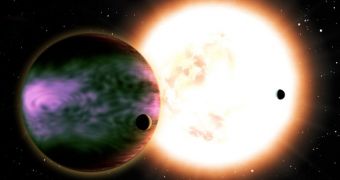Polar lights here on Earth are amazing spectacles, but they can only be noticed from a few, difficult-to-access regions. Inspired by these sights, a group of experts decided to investigate how these phenomena would look like on a class of extrasolar planets called hot Jupiters.
Here on Earth, the intensity of the Northern and Southern Lights are dictated by the amount of charged solar particles that make their way into our planet's atmosphere. We are located one astronomical unit away from the star, the equivalent of about 93 million miles.
Whenever a large solar flare or coronal mass ejection occurs, auroras brighten, but they still remain confined to areas around the pole. This is most definitely not the case on hot Jupiters, experts say.
This class of exoplanets got its name from the fact that the planets themselves are about as large and heavy as Jupiter, maybe even more so, but are also located extremely close to their parent stars. Some are located as close as Mercury is to the Sun, at 0.30 to 0.46 astronomical units.
The atmosphere around such a gas giant would most likely include a tremendously strong magnetosphere. Given the close proximity to the parent star, it stands to reason that these layers are battered with massive volumes of radiation.
Astronomers at the Harvard-Smithsonian Center for Astrophysics (CfA) say that this most likely makes auroras on hot Jupiters between 100 and 1,000 times brighter than those on Earth. The light shows would extend from the poles all the way to the Equator.
“I'd love to get a reservation on a tour to see these aurorae!” says the lead author of the new investigation, CfA SHINE-NSF postdoctoral fellow Ofer Cohen. His work was sponsored by the US National Science Foundation.
“The impact [a solar storm would cause] to the exoplanet would be completely different than what we see in our solar system, and much more violent,” CfA expert and study coauthor Vinay Kashyap adds.
Interestingly, despite such harsh conditions, the magnetosphere around most hot Jupiters is perfectly capable of preventing the entire atmosphere from escaping into space and being destroyed.
“Our calculations show how well the planet's protective mechanism works. Even a planet with a magnetic field much weaker than Jupiter's would stay relatively safe,” Cohen goes on to say.
Details of the new work appear in the latest issue of the latest online issue of the Astrophysical Journal, and will be published in an upcoming print issue of the journal as well.
Headquartered in Cambridge, Massachusetts, the CfA is a joint collaboration between the Smithsonian Astrophysical Observatory and the Harvard College Observatory. CfA scientists, organized into six research divisions, study the origin, evolution and ultimate fate of the Universe.

 14 DAY TRIAL //
14 DAY TRIAL //